Monitoring 10-m LST from the Combination MODIS/Sentinel-2, Validation in a High Contrast Semi-Arid Agroecosystem
Abstract
1. Introduction
2. Materials and Methods
2.1. Study Site and Measurements
2.2. Satellite Images
2.3. Downscaling Approach
- The aggregation of the VNIR bands was carried out by averaging the reflectance values in the red and NIR bands of the 10-m S2 pixels, and 250-m MODIS pixels within an equivalent 1000 m MODIS pixel;
- NDVI values were calculated from both S2 (NDVIS2) and MODIS (NDVIMOD) VNIR data at 1000 m resolution;
- Differences between S2 and MODIS VNIR data due to spectral resolution, atmospheric correction, viewing angle or pixel footprint were corrected through a normalization extracted from the 1000 m NDVI, then applied to 10-m S2 NDVI (NDVIN);
- The 1000 m coarse spatial resolution required a previous selection of “pure” pixels for the NDVI-LST adjustment. This selection was based on a confidence value calculated from the comparison between NDVIMOD and aggregated NDVIN. This confidence value was computed as the ratio between the standard deviation from the 4 × 4 pixels belonging to each 1000 m pixel, and its mean value, as suggested by [18]. Pixels with confidence values within the lowest quartile were selected in this step;
- A linear regression was established between NDVIMOD and LSTMOD at 1000 m, using data from those “pure” pixels, and then applied to the NDVIN values to obtain a prime estimate of 10-m LST (LSTprime);
- The Bisquert et al. [1] algorithm included a residual (RLST) correction to account for the local conditions, and to correct the possible deviations produced by the NDVI-LST equation. This residue was calculated as the difference between the original and predicted LST at a coarse resolution, and this residue value was then added equally to all high-resolution pixels composing a coarse pixel. Since this residual correction leads to some boxy effect, Bisquert et al. [1] used a Gaussian filter to smooth. This final step was revised, and a modification is introduced in this work by adding a smoothing based on a linearization between the residual RLST and the NDVIMOD itself from 1000 m data. This linear relationship between the residue and the NDVI was then applied to 10-m NDVIN (Figure 4);
- Finally, 10-m LST values were obtained by adding this residual RLST to original 10-m LSTprime data from step 5. This new protocol to derive the residue values was expected to reduce the LST deviation, particularly in small size fields surrounded by a different cover, and then contribute to an overall improvement in the model performance.
3. Results
3.1. Ground Validation
3.2. Distributed Assessment
4. Discussions
5. Conclusions
Author Contributions
Funding
Acknowledgments
Conflicts of Interest
References
- Bisquert, M.; Sánchez, J.M.; Caselles, V. Evaluation of Disaggregation Methods for Downscaling Modis Land Surface Temperature to Landsat Spatial Resolution in Barrax Test Site. IEEE J. Sel. Top. Appl. Earth Obs. Remote Sens. 2016, 9, 1430–1438. [Google Scholar] [CrossRef]
- Anderson, M.C.; Kustas, W.P.; Alfieri, J.G.; Gao, F.; Hain, C.; Prueger, J.H.; Evett, S.; Colaizzi, P.; Howell, T.; Chávez, J.L. Mapping Daily Evapotranspiration at Landsat Spatial Scales During the BEAREX’08 Field Campaign. Adv. Water Resour. 2012, 50, 162–177. [Google Scholar] [CrossRef]
- Ha, W.; Gowda, P.; Howell, T. A Review of Downscaling Methods for Remote Sensing-Based Irrigation Management: Part I. Irrig. Sci. 2013, 31, 831–850. [Google Scholar] [CrossRef]
- Guzinski, R.; Anderson, M.C.; Kustas, W.P.; Nieto, H.; Sandholt, I. Using a Thermal Based Two Source Energy Balance Model with Time-Differencing to Estimate Surface Energy Fluxes with Day-Night MODIS Observations. Hydrol. Earth Syst. Sci. 2013, 17, 2809–2825. [Google Scholar] [CrossRef]
- Fisher, J.B. The future of evapotranspiration: Global Requirements for Ecosystem Functioning, Carbon and Climate Feedbacks, Agricultural Management, and Water Resources. Water Resour. Res. 2017, 53, 2618–2626. [Google Scholar] [CrossRef]
- Hulley, G.; Hook, S.; Fisher, J.; Lee, C. Ecostress, A NASA Earth-Ventures Instrument for Studying Links Between the Water Cycle and Plant Health over the Diurnal Cycle. In Proceedings of the 2017 IEEE International Geoscience and Remote Sensing Symposium (IGARSS), Fort Worth, TX, USA, 23–28 July 2017; pp. 5494–5496. [Google Scholar] [CrossRef]
- Sobrino, J.A.; Jiménez-Muñoz, J.C.; Soria, G.; Ruescas, A.B.; Danne, O.; Brockmann, C.; Ghent, D.; Remedios, J.; North, P.; Merchant, C.; et al. Synergistic Use of MERIS and AATSR as a Proxyfor Estimating Land Surface Temperature from Sentinel-3 Data. Remote Sens. Environ. 2016, 179, 149–161. [Google Scholar] [CrossRef]
- Guzinski, R.; Nieto, H. Evaluating the Feasibility of Using Sentinel-2 and Sentinel-3 Satellites for High-Resolution Evapotranspiration Estimations. Remote Sens. Environ. 2019, 221, 157–172. [Google Scholar] [CrossRef]
- He, B.-J.; Zhao, Z.-Q.; Shen, L.-D.; Wang, H.-B.; Li, L.-G. An Approach to Examining Performances of Cool/Hot Sources in Mitigating/Enhancing Land Surface Temperature under Different Temperature Backgrounds Based on Landsat 8 Image. Sustain. Cities Soc. 2019, 44, 416–427. [Google Scholar] [CrossRef]
- Merlin, O.; Duchemin, B.; Hagolle, O.; Jacob, F.; Coudert, B.; Chehbouni, G.; Dedieu, G.; Garatuza, J.; Kerr, Y. Disaggregation of MODIS Surface Temperature over an Agricultural Area Using a Time Series of Formosat-2 Images. Remote Sens. Environ. 2010, 114, 2500–2512. [Google Scholar] [CrossRef]
- Lagouarde, J.-P. The MISTIGRI Thermal Infrared Project: Scientific Objectives and Mission Specifications. Int. J. Remote Sens. 2013, 34, 3437–3466. [Google Scholar] [CrossRef]
- Koetz, B.; Berger, M.; Blommaert, J.; Del Bello, U.; Drusch, M.; Duca, R.; Gascon, F.; Ghent, D.; Hoogeveen, J.; Hook, S.; et al. Copernicus High Spatio-Temporal Resolution Land Surface Temperature Mission: Mission Requirements Document; ESA: Noordwijk, The Netherlands, 2019. [Google Scholar]
- Lagouarde, J.-P. The Indian-French Trishna Mission: Earth Observation in the Thermal Infrared with High Spatio-Temporal Resolution. In Proceedings of the IGARSS 2018—2018 IEEE International Geoscience and Remote Sensing Symposium, Valencia, Spain, 22–27 July 2018; pp. 4078–4081. [Google Scholar] [CrossRef]
- Jeganathan, C.; Hamm, N.A.S.; Mukherjee, S.; Atkinson, P.M.; Raju, P.L.N.; Dadhwal, V.K. Evaluating a Thermal Image Sharpening Model over a Mixed Agricultural Landscape in India. Int. J. Appl. Earth Obs. Geoinform. 2011, 13, 178–191. [Google Scholar] [CrossRef]
- Zhan, W.; Chen, Y.; Zhou, J.; Wang, J.; Liu, W.; Voogt, J.; Zhu, Z.; Quan, J.; Li, J. Disaggregation of Remotely Sensed Land Surface Temperature: Literature Survey, Taxonomy, Issues, and Caveats. Remote Sens. Environ. 2013, 131, 119–139. [Google Scholar] [CrossRef]
- Cammalleri, C.; Anderson, M.C.; Gao, F.; Hain, C.R.; Kustas, W.P. A Data Fusion Approach for Mapping Daily Evapotranspiration at Field Scale. Water Resour. Res. 2013, 49, 4672–4686. [Google Scholar] [CrossRef]
- Yang, Y.; Li, X.; Pan, X.; Zhang, Y.; Cao, C. Downscaling Land Surface Temperature in Complex Regions by Using Multiple Scale Factors with Adaptive Thresholds. Sensors 2017, 17, 744. [Google Scholar] [CrossRef]
- Kustas, W.P.; Norman, J.M.; Anderson, M.C.; French, A.N. Estimating Subpixel Surface Temperatures and Energy Fluxes from the Vegetation Index–Radiometric Temperature Relationship. Remote Sens. Environ. 2003, 85, 429–440. [Google Scholar] [CrossRef]
- Agam, N.; Kustas, W.P.; Anderson, M.C.; Li, F.; Neale, C.M.U. A Vegetation Index Based Technique for Spatial Sharpening of Thermal Imagery. Remote Sens. Environ. 2007, 107, 545–558. [Google Scholar] [CrossRef]
- Gao, F.; Kustas, W.; Anderson, M. A Data Mining Approach for Sharpening Thermal Satellite Imagery over Land. Remote Sens. 2012, 4, 3287–3319. [Google Scholar] [CrossRef]
- Bindhu, V.M.; Narasimhan, B.; Sudheer, K.P. Development and Verification of a Non-Linear Disaggregation Method (NL-Distrad) to Downscale MODIS Land Surface Temperature to the Spatial Scale of Landsat Thermal Data to Estimate Evapotranspiration. Remote Sens. Environ. 2013, 135, 118–129. [Google Scholar] [CrossRef]
- Ghosh, A.; Joshi, P.K. Hyperspectral Imagery for Disaggregation of Land Surface Temperature with Selected Regression Algorithms over Different Land Use Land Cover Scenes. ISPRS J. Photogramm. Remote Sens. 2014, 96, 76–93. [Google Scholar] [CrossRef]
- Eswar, R.; Sekhar, M.; Bhattacharya, B.K. Disaggregation of LST over India: Comparative Analysis of Different Vegetation Indices. Int. J. Remote Sens. 2016, 37, 1035–1054. [Google Scholar] [CrossRef]
- Liu, K.; Wand, S.; Li, X.; Li, Y.; Zhang, B.; Zhai, R. The Assessment of Different Vegetation Indices for Spatial Disaggregating of Thermal Imagery over the Humid Agricultural Region. Int. J. Remote Sens. 2019, 41, 1907–1926. [Google Scholar] [CrossRef]
- Amazirh, A.; Merlin, O.; Er-Raki, S. Including Sentinel-1 Radar Data to Improve the Disaggregation of MODIS Land Surface Temperature Data. ISPRS J. Photogramm. Remote Sens. 2019, 150, 11–26. [Google Scholar] [CrossRef]
- Bisquert, M.; Sánchez, J.M.; López-Urrea, R.; Caselles, V. Estimating High Resolution Evapotranspiration from Disaggregated Thermal Images. Remote Sens. Environ. 2016, 187, 423–433. [Google Scholar] [CrossRef]
- Sobrino, J.; Jiménez-Muñoz, J.; Brockmann, C.; Ruescas, A.; Danne, O.; North, P.; Heckel, A.; Davies, W.; Berger, M.; Merchant, C.; et al. Land Surface Temperature Retrieval from Sentinel 2 and 3 Missions. In Proceedings of the Sentinel-3 OLCI/SLSTR and MERIS/(A)ATSR Workshop, Frascati, Italy, 15–19 October 2012; Ouwehand, L., Ed.; ESA Communications: Oakville, ON, Canada, 2013. ISBN 9789290922759 (SP-711). [Google Scholar]
- Huryna, H.; Cohen, Y.; Karnieli, A.; Panov, N.; Kustas, W.P.; Agam, N. Evaluation of Tsharp Utility for Thermal Sharpening of Sentinel-3 Satellite Images Using Sentinel-2 Visual Imagery. Remote Sens. 2019, 11, 2304. [Google Scholar] [CrossRef]
- Moreno, J.F. “The SPECTRA Barrax campaign (SPARC): Overview and First Results from CHRIS Data”. In Proceedings of the Second CHRIS/Proba Workshop, ESA SP-578, Frascati, Italy, 28–30 April 2004. [Google Scholar]
- Sobrino, J.A. Thermal Remote Sensing in the Framework of the SEN2FLEX Project: Field Measurements, Airborne Data and Applications. Int. J. Remote Sens. 2008, 29, 4961–4991. [Google Scholar] [CrossRef]
- Latorre, C. Seasonal Monitoring of FAPAR Over the Barrax Cropland Site in Spain, In Support of the Validation of PROBA-V Products at 333 m. In Proceedings of the Recent Advances in Quantitative Remote Sensing, Torrent, Spain, 22–26 September 2014; pp. 431–435. [Google Scholar]
- Niclòs, R.; Pérez-Planells, L.l.; Coll, C.; Valiente, J.A.; Valor, E. Evaluation of the S-NPP VIIRS Land Surface Temperature Product Using Ground Data Acquired by an Autonomous System at a Rice Paddy. ISPRS J. Photogramm. Remote Sens. 2018, 135, 1–12. [Google Scholar] [CrossRef]
- Sánchez, J.M.; López-Urrea, R.; Rubio, E.; González-Piqueras, J.; Caselles, V. Assessing Crop Coefficients of Sunflower and Canola Using Two-Source Energy Balance and Thermal Radiometry. Agric. Water Manag. 2014, 137, 23–29. [Google Scholar] [CrossRef]
- Gillespie, A.; Rokugawa, S.; Matsunaga, T.; Cothern, J.S.; Hook, S.; Kahle, A.B. A Temperature and Emissivity Separation from Advanced Spaceborne Thermal Emission and Reflection Radiometer (ASTER) Images. IEEE Trans. Geosci. Remote Sens. 1998, 36, 1113–1126. [Google Scholar] [CrossRef]
- Sánchez, J.M.; French, A.N.; Mira, M.; Hunsaker, D.J.; Thorp, K.R.; Valor, E.; Caselles, V. Thermal Infrared Emissivity Dependence on Soil Moisture in Field Conditions. IEEE Trans. Geosci. Remote Sens. 2011, 49, 4652–4659. [Google Scholar] [CrossRef]
- Legrand, M.; Pietras, C.; Brogniez, G.; Haeffelin, M.; Abuhassan, N.K.; Sicard, M.A. high-Accuracy Multiwavelength Radiometer for in Situ Measurements in the Thermal Infrared. Part I: Characterization of the Instrument. J. Atmos. Ocean Technol. 2000, 17, 1203–1214. [Google Scholar] [CrossRef]
- Wolfe, R.E.; Nishihama, M.; Fleig, A.J.; Kuyper, J.A.; Roy, D.P.; Storey, J.C.; Patt, F.S. Achieving Sub-Pixel Geolocation Accuracy in Support of MODIS Land Science. Remote Sens. Environ. 2002, 83, 31–49. [Google Scholar] [CrossRef]
- Wan, Z. New Refinements and Validation of the MODIS Land Surface Temperature/Emissivity Products. Remote Sens. Environ. 2008, 112, 59–74. [Google Scholar] [CrossRef]
- Galve, J.M.; Sánchez, J.M.; Coll, C.; Villodre, J. A New Single-Band Pixel-By-Pixel Atmospheric Correction Method to Improve the Accuracy in Remote Sensing Estimates of LST. Application to Landsat 7-ETM+. Remote Sens. 2018, 10, 826. [Google Scholar] [CrossRef]
- Willmott, C.J. Some Comments on the Evaluation of Model Performance. Bull. Am. Meteorol. Soc. 1982, 63, 1309–1313. [Google Scholar] [CrossRef]
- Schneider, P.; Ghent, D.; Corlett, G.; Prata, F.; Remedios, J. Land Surface Temperature Validation Protocol; ESA: Noordwijk, The Netherlands, 2012. [Google Scholar]
- Essa, W.; Verbeiren, B.; van der Kwast, J.; Batelaan, O. Improved DisTrad for Downscaling Thermal MODIS Imagery over Urban Areas. Remote Sens. 2017, 9, 1243. [Google Scholar] [CrossRef]
- Liu, Y.; Hiyama, T.; Yamaguchi, Y. Scaling of Land Surface Temperature Using Satellite Data: A Case Examination on ASTER and MODIS Products over a Heterogeneous Terrain Area. Remote Sens. Environ. 2006, 105, 115–128. [Google Scholar] [CrossRef]
- Weng, Q.; Fu, P.; Gao, F. Generating Daily Land Surface Temperature at Landsat Resolution by Fusing Landsat and MODIS Data. Remote Sens. Environ. 2014, 145, 55–67. [Google Scholar] [CrossRef]
- Brown, M.E.; Pinzon, J.E.; Didan, K.; Morisette, J.T.; Tucker, C.J. Evaluation of the Consistency of Long-Term NDVI Time Series Derived from AVHRR, SPOT-Vegetation, Seawifs, MODIS, and Landsat ETM+ Sensors. IEEE Trans. Geosci. Remote Sens. 2006, 44, 1787–1793. [Google Scholar] [CrossRef]
- Ghent, D.J.; Corlett, G.K.; Göttsche, F.M.; Remedios, J.J. Global Land Surface Temperature from the Along Track Scanning Radiometers. J. Geophys. Res. Atmos. 2017, 122, 12167–12193. [Google Scholar] [CrossRef]
- Allen, R.; Tasumi, M.; Trezza, R. Satellite-Based Energy Balance for Mapping Evapotranspiration with Internalized Calibration (METRIC)\97 Model. J. Irrig. Drain. Eng. 2007, 133, 380–394. [Google Scholar] [CrossRef]
- Sánchez, J.M.; Kustas, W.P.; Caselles, V.; Anderson, M. Modelling Surface Energy Fluxes over Maize Using a Two-Source Patch Model and Radiometric Soil and Canopy Temperature Observations. Remote Sens. Environ. 2008, 112, 1130–1143. [Google Scholar] [CrossRef]
- Duan, S.-B.; Li, Z.L. Spatial Downscaling of MODIS Land Surface Temperatures Using Geographically Weighted Regression: Case Study in Northern China. IEEE Trans. Geosci. Remote Sens. 2016, 54, 6458–6469. [Google Scholar] [CrossRef]
- Sadeghi, M.; Babaeian, E.; Tuller, M.; Jones, S.B. The Optical Trapezoid Model: A Novel Approach to Remote Rensing of Soil Moisture Applied to Sentinel-2 and Landsat-8 Observations. Remote Sens. Environ. 2017, 198, 52–68. [Google Scholar] [CrossRef]
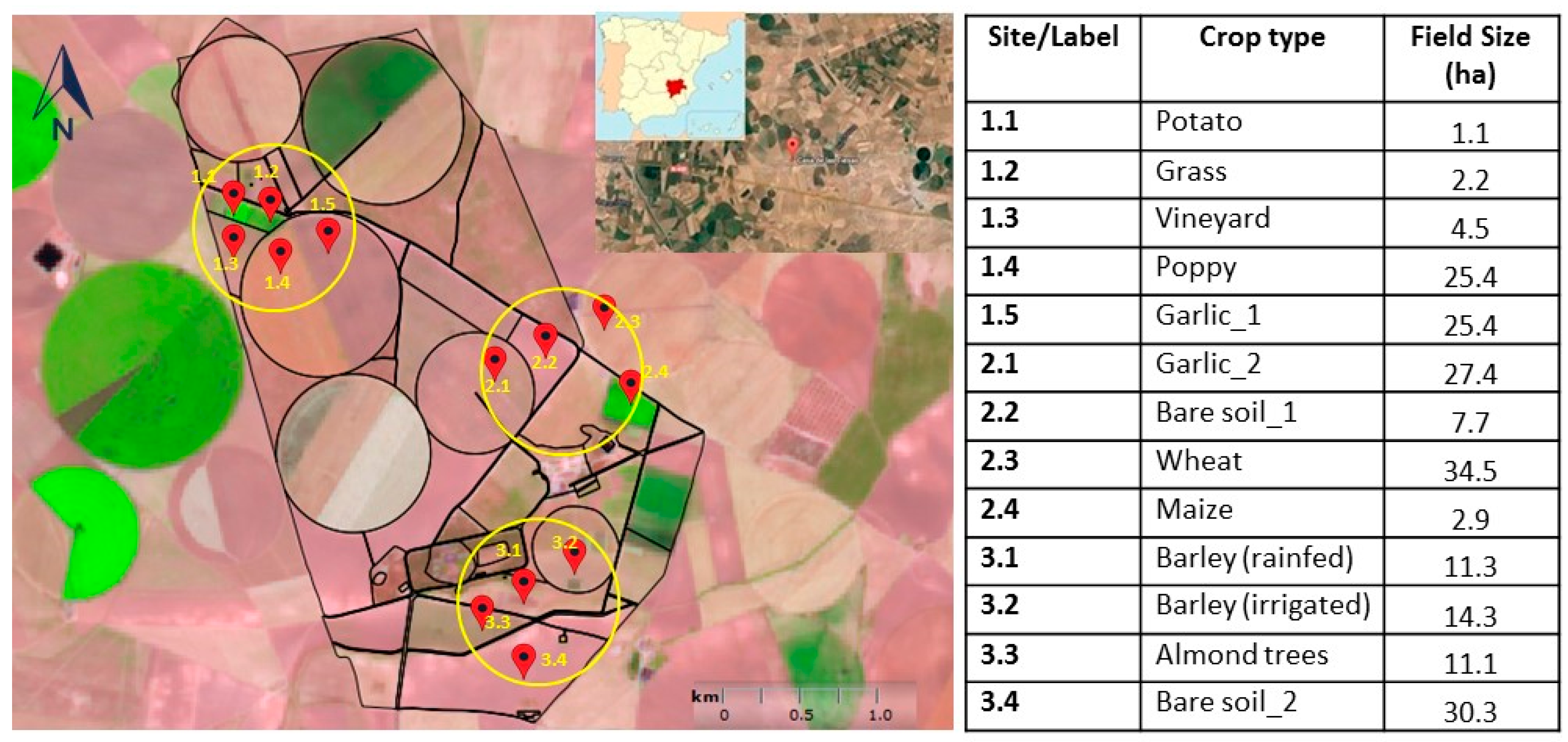

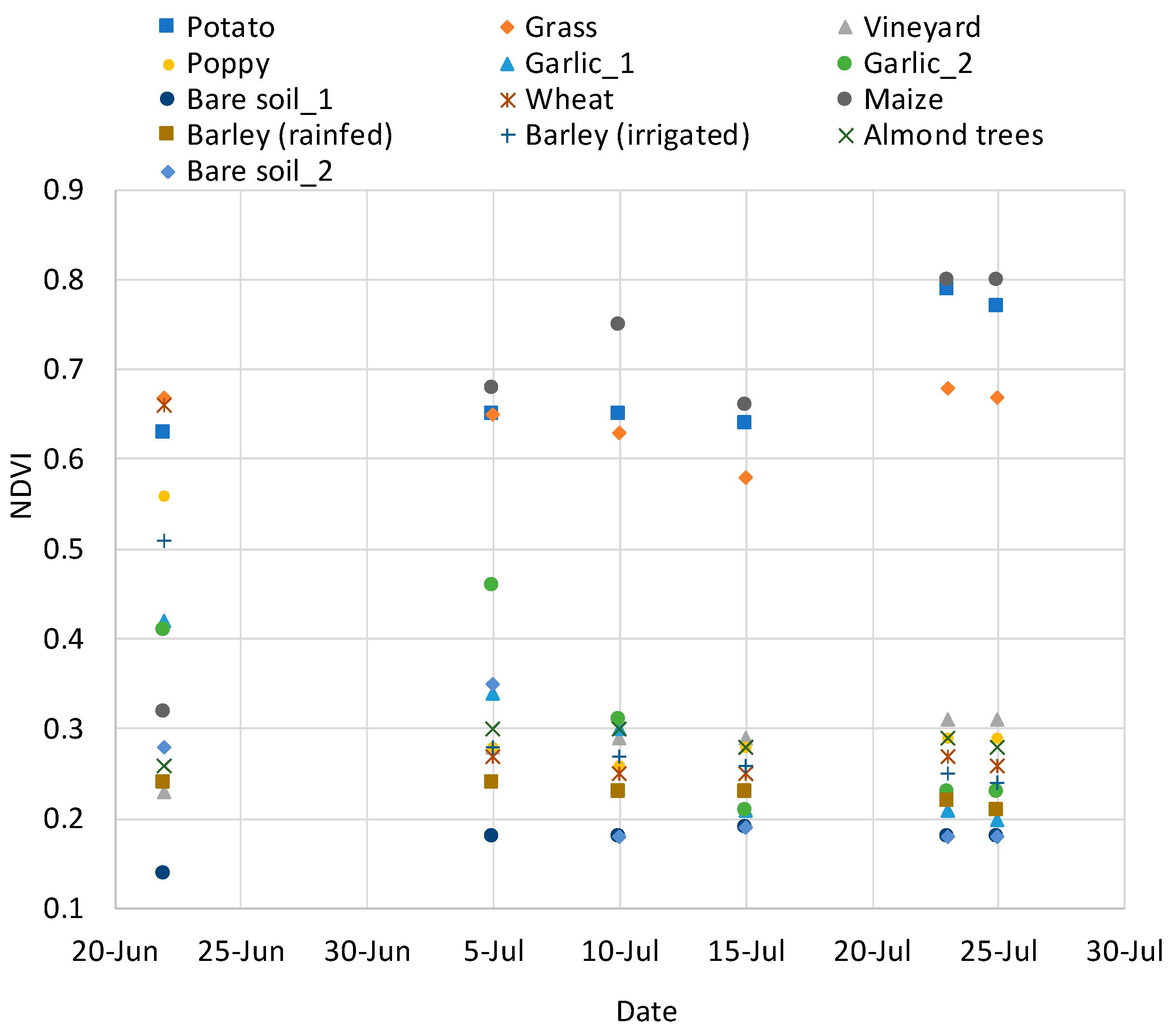
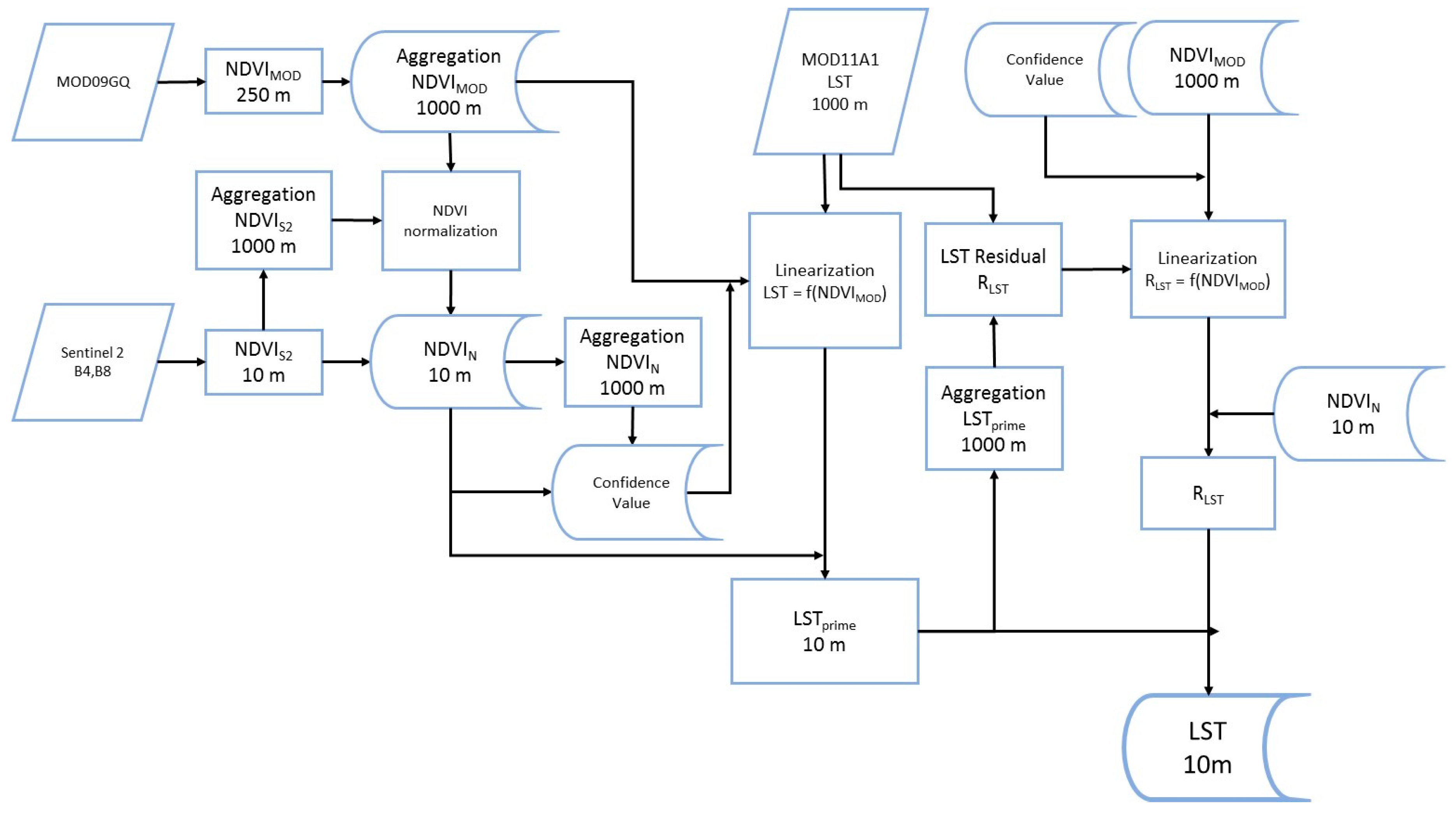
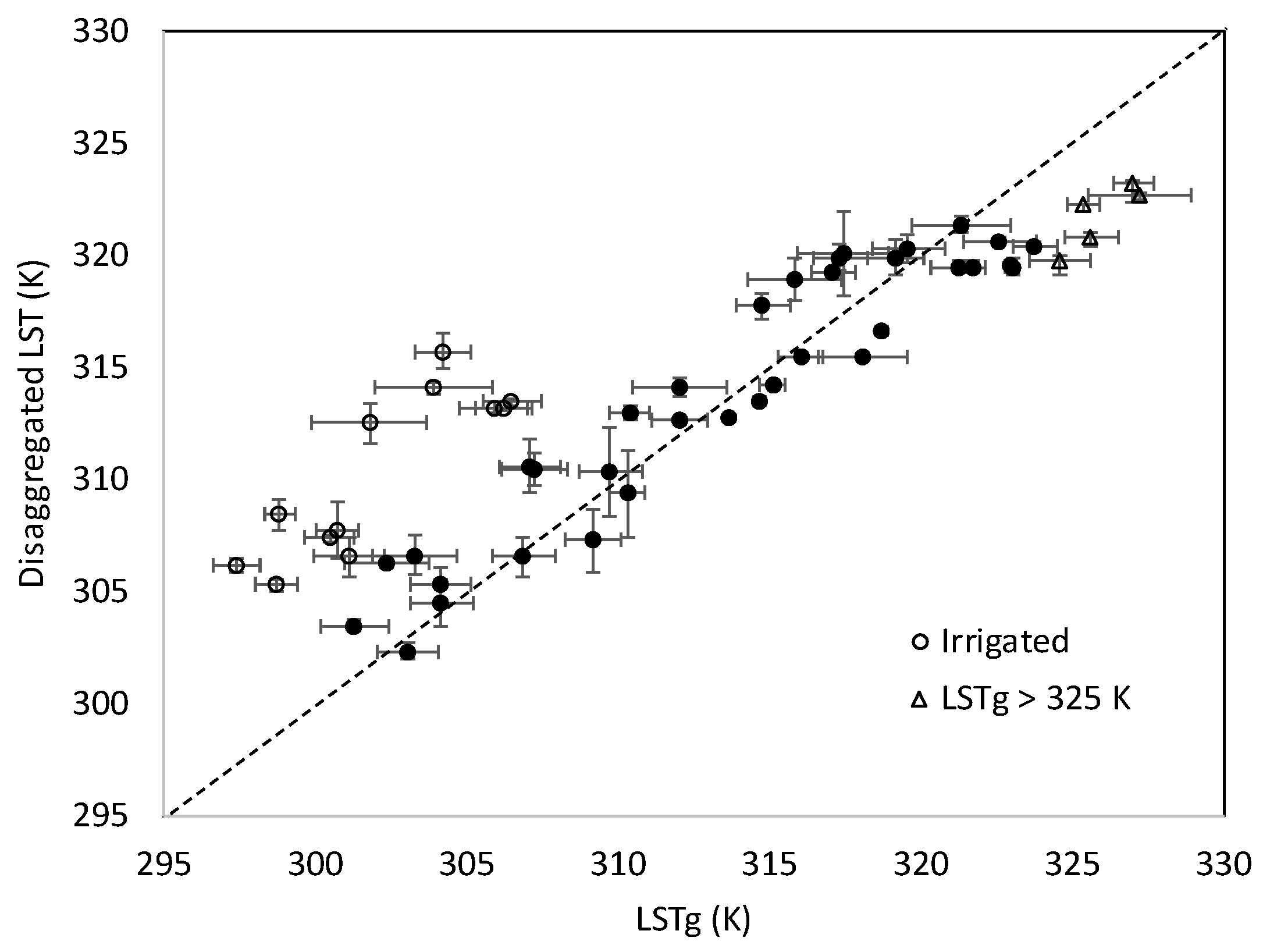
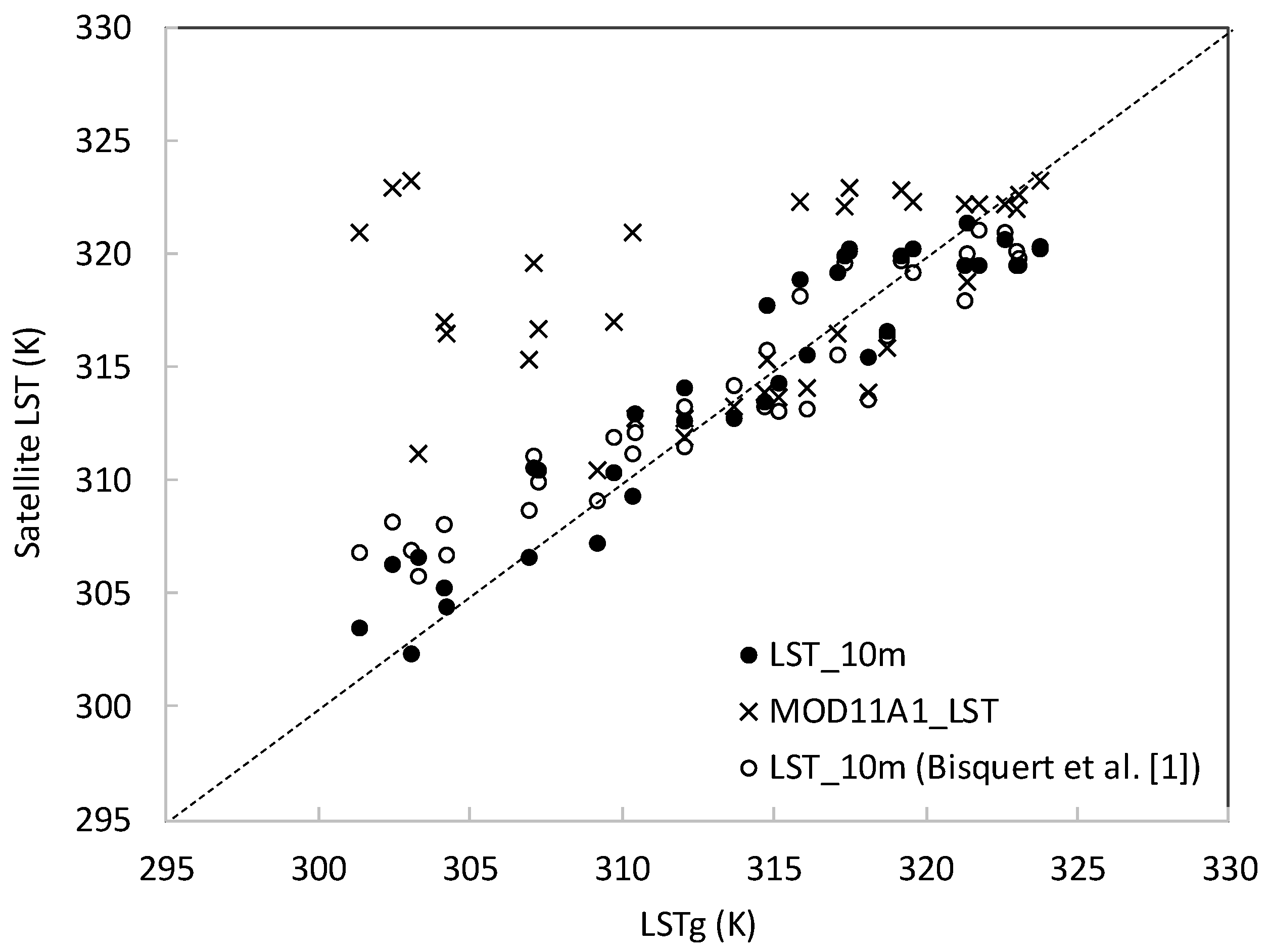
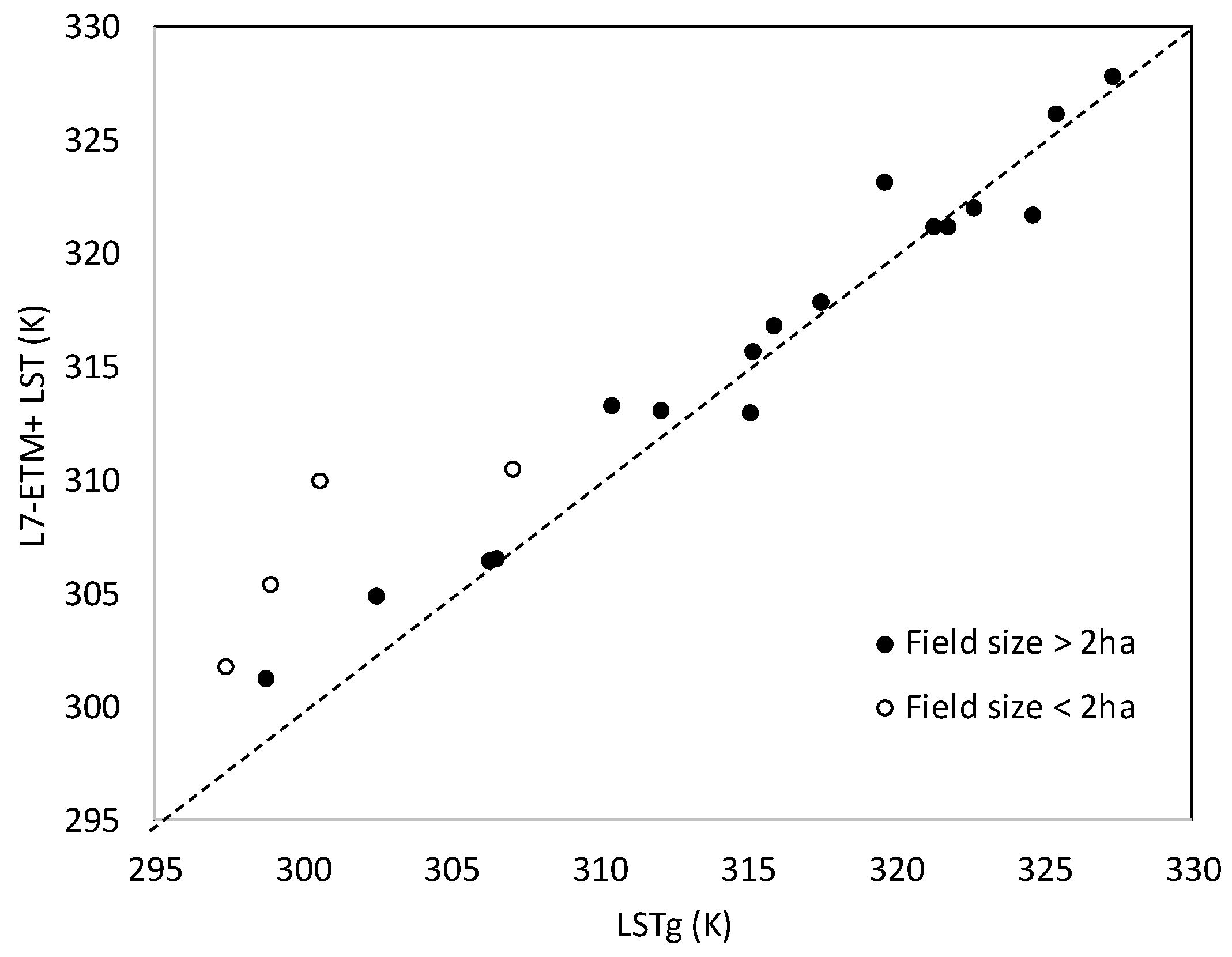
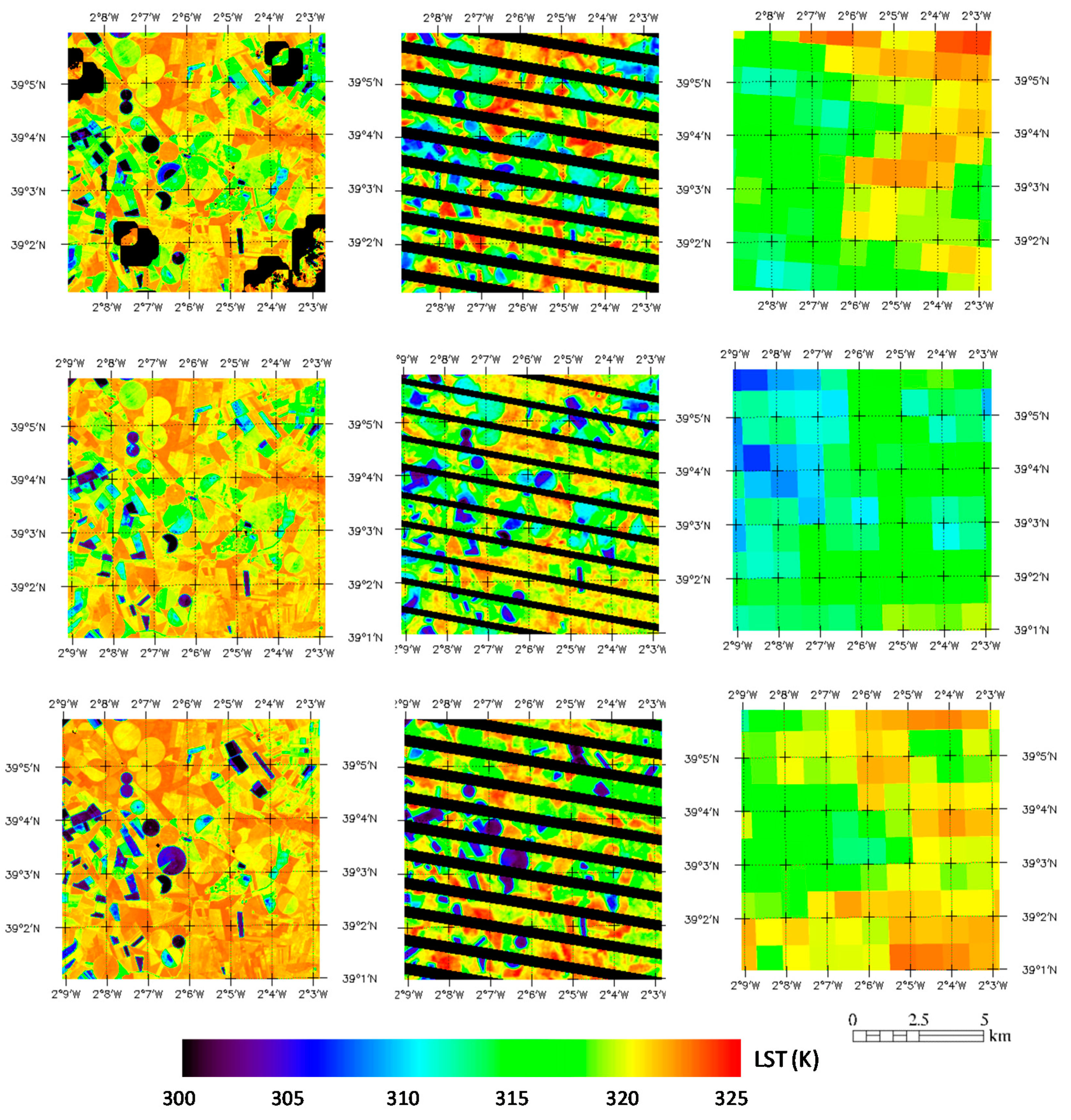
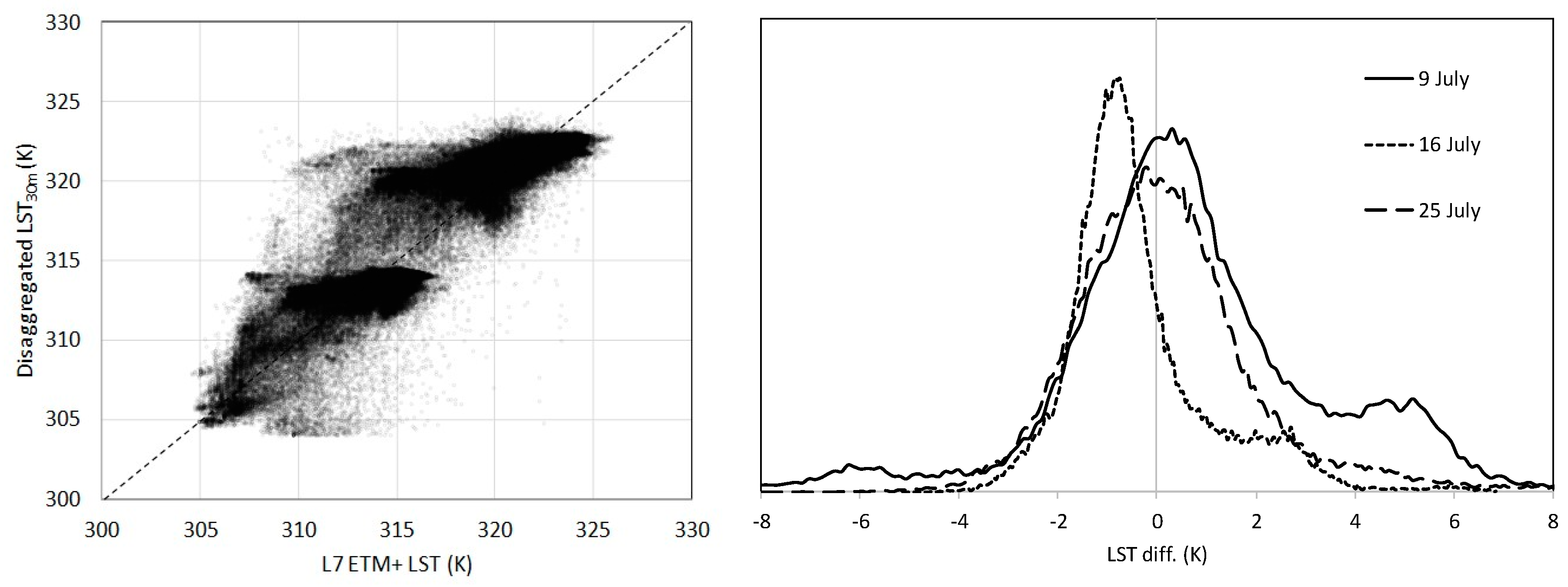
| Terra/MODIS | Sentinel-2 | Landsat-7/ETM+ | LSTg Data | Ta | Hr | u | ||
|---|---|---|---|---|---|---|---|---|
| Date | Time | Viewing Angle (°) | (A/B) | (Path/Row)-Time | (N) | (°C) | (%) | (ms−1) |
| 22 June | 11:14 | 19 | A (22 June) | no image | 9 | 28.2 | 33.1 | 2.4 |
| 5 July | 11:17 | 10 | B (5 July) | no image | 9 | 23.9 | 37.1 | 3.9 |
| 9 July | 11:02 | 0 | A (10 July) | (199/33)-10:32 | 7 | 30.1 | 33.0 | 1.5 |
| 16 July | 11:08 | 12 | B (15 July) | (200/33)-10:38 | 8 | 24.3 | 37.3 | 6.4 |
| 23 July | 11:14 | 24 | A (23 July) | no image | 9 | 29.7 | 34.1 | 1.5 |
| 25 July | 11:02 | 2 | B (25 July) | (199/33)-10:32 | 9 | 28.6 | 37.6 | 2.0 |
| N = 34 | Min (K) | Max (K) | Bias (K) | SD (K) | MAD (K) | MADP (%) | RMSD (K) | r2 | Me (K) | RSD (K) | R-RMSD (K) | S | K |
|---|---|---|---|---|---|---|---|---|---|---|---|---|---|
| LST10m | −3.6 | 3.9 | 0.2 | 2.2 | 1.9 | 0.6 | 2.2 | 0.90 | 0.2 | 2.8 | 2.8 | −0.04 | −1.2 |
| LST10m (Bisquert et al. [1]) | −4.5 | 5.7 | 0.4 | 2.7 | 2.3 | 0.7 | 2.7 | 0.90 | 0.5 | 3.3 | 3.4 | 0.06 | −0.8 |
| LST_MOD | −4.2 | 20.5 | 4.4 | 6.8 | 5.4 | 1.7 | 8.0 | 0.10 | 1.2 | 7.7 | 7.8 | 1.1 | 0.3 |
| N | Bias (K) | SD (K) | MAD (K) | MADP (%) | RMSD (K) | r2 | Me (K) | RSD (K) | R-RMSD (K) | |
|---|---|---|---|---|---|---|---|---|---|---|
| 9 July | 67826 | 0.7 | 2.5 | 1.9 | 0.6 | 2.6 | 0.55 | 0.5 | 2.8 | 2.8 |
| 16 July | 116015 | −0.4 | 1.4 | 1.2 | 0.4 | 1.4 | 0.63 | −0.6 | 1.7 | 1.8 |
| 25 July | 90804 | 0.9 | 1.8 | 1.5 | 0.5 | 2.0 | 0.75 | 0.8 | 2.2 | 2.3 |
| Average | 274643 | 0.3 | 1.9 | 1.4 | 0.5 | 2.0 | 0.82 | 0.010 | 2.1 | 2.1 |
© 2020 by the authors. Licensee MDPI, Basel, Switzerland. This article is an open access article distributed under the terms and conditions of the Creative Commons Attribution (CC BY) license (http://creativecommons.org/licenses/by/4.0/).
Share and Cite
Sánchez, J.M.; Galve, J.M.; González-Piqueras, J.; López-Urrea, R.; Niclòs, R.; Calera, A. Monitoring 10-m LST from the Combination MODIS/Sentinel-2, Validation in a High Contrast Semi-Arid Agroecosystem. Remote Sens. 2020, 12, 1453. https://doi.org/10.3390/rs12091453
Sánchez JM, Galve JM, González-Piqueras J, López-Urrea R, Niclòs R, Calera A. Monitoring 10-m LST from the Combination MODIS/Sentinel-2, Validation in a High Contrast Semi-Arid Agroecosystem. Remote Sensing. 2020; 12(9):1453. https://doi.org/10.3390/rs12091453
Chicago/Turabian StyleSánchez, Juan M., Joan M. Galve, José González-Piqueras, Ramón López-Urrea, Raquel Niclòs, and Alfonso Calera. 2020. "Monitoring 10-m LST from the Combination MODIS/Sentinel-2, Validation in a High Contrast Semi-Arid Agroecosystem" Remote Sensing 12, no. 9: 1453. https://doi.org/10.3390/rs12091453
APA StyleSánchez, J. M., Galve, J. M., González-Piqueras, J., López-Urrea, R., Niclòs, R., & Calera, A. (2020). Monitoring 10-m LST from the Combination MODIS/Sentinel-2, Validation in a High Contrast Semi-Arid Agroecosystem. Remote Sensing, 12(9), 1453. https://doi.org/10.3390/rs12091453








